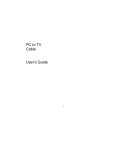Download ATI Technologies RADEON 117-40122-20 User's Manual
Transcript
4012220.fm Page 1 Friday, July 7, 2000 11:23 AM RADEON™ Using Video In/Video Out P/N: 117-40122-20 ATI and RADEON are registered trademarks of ATI Technologies Inc. Windows is a registered trademark of Microsoft Corporation in the United States and/or other countries. Products may not be exactly as shown. Features, performance, and specifications may vary depending on operating environment and are subject to change without notice. Copyright © ATI Technologies Inc. 2000. All rights reserved. Printed in Canada 4012220.fm Page 2 Friday, July 7, 2000 11:23 AM Using Video In Capture full motion or still image video Your new RADEON™ graphics card has Video In (also known as Composite In) capability for capturing full motion or still image video. Just attach a video device such as a VCR, camcorder, or laser disk player to the Video In connector on the back of your new graphic card. Connecting a Video Device To connect your computer to a video device such as a VCR, camcorder, or laser disk player, attach a composite cable from the Composite Output connector on your VCR, camcorder, or laser disk player to the Video In on your graphic card. Most video devices such as VCRs, camcorders, and laser disk players have a Composite Output, also referred to as an RCA output. Connecting Your video device 1 2 3 4 Turn off your computer and your VCR, camcorder, or laser disk player. Ensure your graphics card is installed correctly. Locate the Composite Output on your VCR, camcorder, or laser disk player. Looking at the back of your computer, locate your graphics card. Using a Composite cable, attach one end of the cable to the Video In on your graphics card and the other to the Composite Output on your video device. 5 Turn on your computer and your video device. 6 Use the ATI Multimedia Center to capture streaming Video or still images. For detailed information on video capture, and various capture formats available, refer to the Online User’s Guide included with your ATI Install CD ROM. 4012220.fm Page 3 Friday, July 7, 2000 11:23 AM Using Video Out View your PC’s display on a television! Your new RADEON™ graphics card has Video Out (also known as TV Out) capability. Just attach your new card to a television, a monitor, or both. You can even attach your graphics card to your VCR and record your computer’s display. Television display is ideal for playing games, giving presentations, watching movies, and browsing the Internet. The following tips will help you get the most out of your Video Out feature. READ ME FIRST IMPORTANT INFORMATION for European Customers • Some PC monitors in Europe cannot be used simultaneously with television display. When you enable television display in Europe, the refresh rate for the monitor and television is set to 50Hz. Some monitors may not support this refresh rate and could be damaged. Please check the documentation supplied with your monitor to see if your monitor supports a refresh rate of 50Hz. If your monitor does not support 50 Hz (or you are not sure), then turn off your monitor before turning on your computer when using your television as a display. For information about how to disable television display, see Enabling and Disabling the Television Display on page 5. • Some televisions in Europe may use a SCART connection. If you use SCART, read Using SCART Connectors for European Televisions on page 5 before attempting to connect your PC to your television. Connecting your PC to a television or a VCR To connect your computer to a television or a VCR, attach a connector cable from the television (or VCR) to your card. Most televisions and VCRs have a Composite video input, also referred to as a phono jack or RCA input. A growing number of televisions and VCRs have another type of video input called S-Video or S-VHS. An S-Video connection produces a higher quality display than Composite video. If your television has cable input only, which is the case on older units, you can connect your graphics card to your television using your VCR or an RF modulator (available in most electronics stores). RADEON™ Using Video In/Video Out 3 4012220.fm Page 4 Friday, July 7, 2000 11:23 AM Connecting Your Video Out Graphics Card to a Television or VCR 1 Turn off your computer and your television or VCR. 2 Ensure your graphics card is installed correctly. To use television display, you need the enhanced ATI driver (version 6.0 or greater) installed on your system. For information about placing the card in your computer and installing the enhanced ATI driver, see the Getting Started guide. 3 Determine if your television or VCR has an S-Video or Composite video connection. 4 Looking at the back of your computer, locate your graphics card. Using an S-Video or Composite cable, attach one end of the cable to your graphics card and the other to your television or VCR. (See Figure 1. Connecting your ATI RADEON™ card to a TV or VCR below.) 5 Turn on your computer and your television or VCR. 6 To turn your television display on and off, please see Enabling and Disabling the Television Display on page 5. If there is no display on your television, you may need to switch your television to video display. For more information, see the documentation supplied with your television. If you have a television connected to your VCR, you can use the television as your computer’s display. For information about connecting a television to your VCR, see the documentation that came with your VCR. Video Input Composite Out S-Video Output TV OR VGA Monitor Connector VCR Composite Input OR S-Video Input Computer Composite Cable OR S-Video Cable Figure 1. Connecting your ATI RADEON™ card to a TV or VCR 4 ATI Technologies Inc. 4012220.fm Page 5 Friday, July 7, 2000 11:23 AM Using SCART Connectors for European Televisions Figure 2. Using a SCART connector with a Composite cable The SCART connector supports only the Composite video format, which is the most common type. Figure 2 shows how to connect to a SCART connector with a Composite cable. If your television supports S-Video (also called S-VHS) video input, you can use an S-Video cable (available in most consumer electronic stores) to view your PC on a television. Using and Adjusting Video Out Enabling and Disabling the Television Display Start Windows®. Click Start. Point to Settings, then click Control Panel. Double-click Display. Click on the ATI Displays tab. Windows® 98 / Me / 2000 users: Click on the Settings tab and then the Advanced button, before clicking the ATI Displays tab. 6 Click on the green enable/disable button next to the word “TV” to enable/ disable television display. 7 Click OK or Apply to save the changes you have made. For information about how to use television display and the ATI Displays Properties page, click the Help button. 1 2 3 4 5 RADEON™ Using Video In/Video Out 5 4012220.fm Page 6 Friday, July 7, 2000 11:23 AM Starting Windows® with Television Display Enabled The television screen may become scrambled temporarily during the initial Windows® logo display. This is only a temporary effect and your television screen will be restored within a few seconds. During start up, your Video Out graphics card will go through a sequence of mode settings during which your television display will remain blank. This process takes only a few seconds and helps program the television display. Using a Monitor vs. Using the Television Display Using your television for your computer’s display is ideal for playing games, giving presentations, watching movies, and browsing the Internet. The display on your monitor may change or looked squashed. This occurs because the display adjusts to fit the dimensions of your television. To correct the monitor’s display, use the controls on the monitor to adjust the display size and position. Some single frequency monitors may not work with television display enabled. If you experience problems when television display is enabled, disable television display to restore your monitor’s display. Adjusting Monitor Display The size of the display on your monitor may be smaller and not perfectly centered when you have television display enabled. These effects are caused by the changes required to provide a proper display on the television. Use the controls available on the Adjustments tab on the Monitor Properties page (click on the Monitor button on the ATI Displays page) to adjust the display on your monitor only. Click on the Television button to adjust the television display only. Viewing Text on Television Due to the different technology used in the manufacturing of televisions and PC monitors, standard PC text may look too small on your television.You can compensate for this by using larger fonts. To Use Larger Display Fonts Start Windows®. Click Start. Point to Settings, then click Control Panel. Double-click Display. Click on the Settings tab. In the Font Size box, select the size you want your displayed fonts to be. Windows® 98 / Me / 2000 users: Click on the Advanced button; then select your font size. 7 Click OK or Apply; then follow the onscreen instructions to save your new settings. 1 2 3 4 5 6 6 ATI Technologies Inc. 4012220.fm Page 7 Friday, July 7, 2000 11:23 AM Reducing Edge Distortion When using a television for your PC’s display, you may see some edge distortion on the left and right side of your television screen. This effect depends on your television and the PC application you are running. To reduce edge distortion, you can increase the horizontal size. To Increase the Horizontal Size 1 2 3 4 5 6 7 8 9 Start Windows®. Click Start. Point to Settings, then click Control Panel. Double-click Display. Click on the ATI Displays tab. Windows® 98 / Me / 2000 users: Click on the Settings tab and then the Advanced button, before clicking the ATI Displays tab. Click on the TV button. Click on the Adjustments tab. Click on the plus (+) button under Horizontal Screen to increase the horizontal size of the television display. Click OK or Apply to save the changes you have made. You can also reduce edge distortion by reducing the brightness. To Change the Brightness Start Windows®. Click Start. Point to Settings, then click Control Panel. Double-click Display. Click on the ATI Displays tab. Windows® 98 / Me / 2000 users: Click on the Settings tab and then the Advanced button, before clicking the ATI Displays tab. 6 Click on the TV button. 7 Drag the Brightness slider to the left to decrease the brightness. 8 Click OK or Apply to save the changes you have made. 1 2 3 4 5 Changing Display Configurations If you move your computer to a place where you are using television display only, make sure that you have the television display feature enabled; see Enabling and Disabling the Television Display on page 5. RADEON™ Using Video In/Video Out 7 4012220.fm Page 8 Friday, July 7, 2000 11:23 AM If you change your display mode, television display is disabled beyond the 800x600 mode. If a television is your only display device and a non-supported mode is selected, the display on your television will disappear. Try pressing ESC or wait for 15 seconds to see if your display will return. If your display does not return, you will need to hook up a monitor to your computer to re-enable television display. Using Games and Applications Some older games and applications may program the graphics card directly to run under a specific display mode. This may cause your television display to turn off automatically or become scrambled (the PC monitor will not be affected). Your television display will be restored once you exit the game or if you restart your system. 8 ATI Technologies Inc.

















